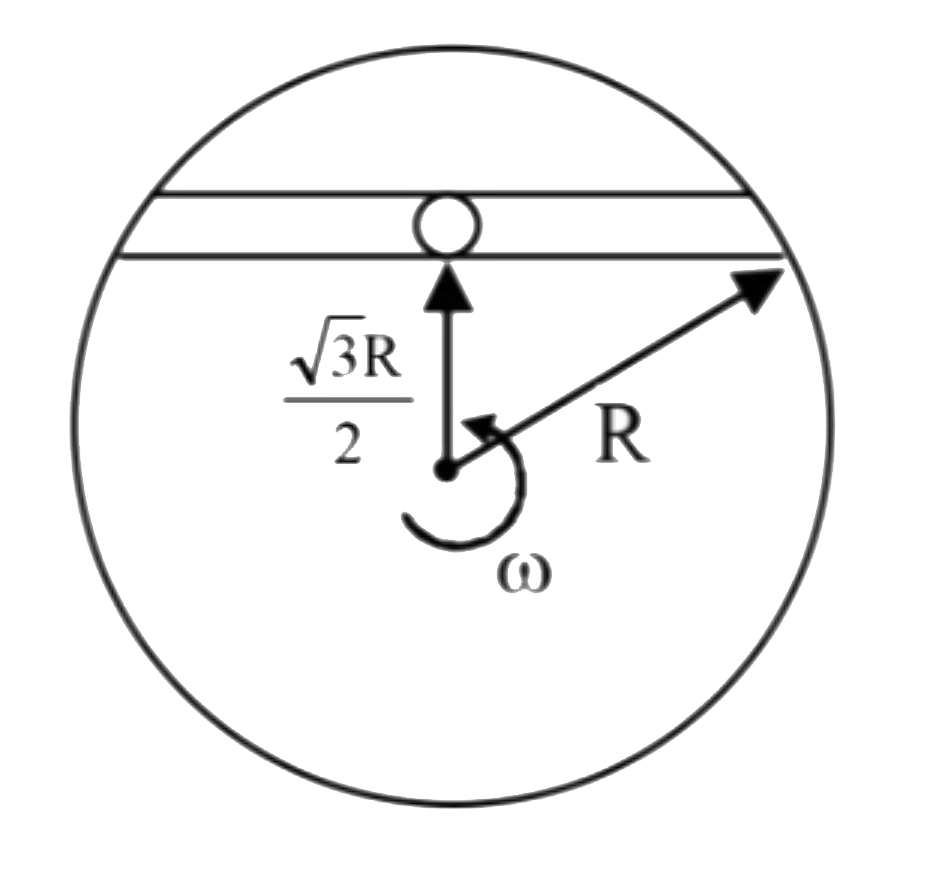A horizontal disc is rotating about a vertical axis passing through its centre. If an insect moves from centre to rim then the angular momentum of the system
First decrease and then increase
Remains constant
Decreases
Increases
To solve the problem of how the angular momentum of a system changes when an insect moves from the center to the rim of a rotating disc, we can follow these steps:
Step 1: Understand the System
We have a horizontal disc rotating about a vertical axis through its center. An insect starts at the center of the disc and moves outward toward the rim.
Step 2: Define Angular Momentum
Angular momentum (L) of a system can be defined as:
L=Iω
where I is the moment of inertia and ω is the angular velocity.
Step 3: Moment of Inertia of the Disc
The moment of inertia of a disc about its center is given by:
Idisc=12MR2
where M is the mass of the disc and R is its radius.
Step 4: Moment of Inertia with the Insect
When the insect is at the center, its contribution to the moment of inertia is negligible. As the insect moves outward, its distance from the axis of rotation increases, thus increasing the total moment of inertia of the system.
The moment of inertia of the insect (assuming it has mass m) when it is at a distance r from the center is:
Iinsect=mr2
Step 5: Total Moment of Inertia
The total moment of inertia when the insect is at a distance r from the center is:
Itotal=Idisc+Iinsect=12MR2+mr2
Step 6: Conservation of Angular Momentum
Since there is no external torque acting on the system, the angular momentum of the system is conserved. Therefore, we can write:
Linitial=Lfinal
Step 7: Initial and Final Angular Momentum
Initially, when the insect is at the center (r = 0):
Linitial=Idisc⋅ω
When the insect moves to the rim (r = R):
Lfinal=(12MR2+mR2)⋅ω′
where ω′ is the new angular velocity after the insect has moved.
Step 8: Relating Initial and Final Angular Momentum
Since angular momentum is conserved:
Idisc⋅ω=(12MR2+mR2)⋅ω′
Step 9: Conclusion
As the insect moves outward, the moment of inertia increases, which means that the angular velocity ω′ must decrease in order to keep the angular momentum constant. Thus, the angular momentum of the system remains constant even though the insect moves from the center to the rim.
We have a horizontal disc rotating about a vertical axis through its center. An insect starts at the center of the disc and moves outward toward the rim.
Angular momentum (L) of a system can be defined as:
L=Iω
where I is the moment of inertia and ω is the angular velocity.
The moment of inertia of a disc about its center is given by:
Idisc=12MR2
where M is the mass of the disc and R is its radius.
When the insect is at the center, its contribution to the moment of inertia is negligible. As the insect moves outward, its distance from the axis of rotation increases, thus increasing the total moment of inertia of the system.
Iinsect=mr2
The total moment of inertia when the insect is at a distance r from the center is:
Itotal=Idisc+Iinsect=12MR2+mr2
Since there is no external torque acting on the system, the angular momentum of the system is conserved. Therefore, we can write:
Linitial=Lfinal
Initially, when the insect is at the center (r = 0):
Linitial=Idisc⋅ω
Lfinal=(12MR2+mR2)⋅ω′
where ω′ is the new angular velocity after the insect has moved.
Since angular momentum is conserved:
Idisc⋅ω=(12MR2+mR2)⋅ω′
As the insect moves outward, the moment of inertia increases, which means that the angular velocity ω′ must decrease in order to keep the angular momentum constant. Thus, the angular momentum of the system remains constant even though the insect moves from the center to the rim.
Similar Questions
A horizontal disc rotating about a vertical axis passing through its centre makes 180 rpm. A small piece of wax of mass 10 g falls vertically on the disc and adheres to it at a distance of 8 cm from its axis. If the frequency is thus reduced to 150 rpm, calculate the moment of inertia of the disc.
View SolutionA horizontal disk is rotating with angular velocity ω about a vertical axis passing through its centre. A ball is placed at the centre of groove and pushed slightly. The velocity of the ball when it comes out of the groove -

View Solution
Knowledge Check
A thin horizontal circular disc is rotating about a vertical axis passing through its centre. An insect is at rest at a point near the rim of the disc. The insect now moves along a diameter of the disc to reach other end. During the journey of the insect, the angular speed of the disc
Aremains unchanged.Bcontinuously decreases.Ccontinuously increases.Dfirst increases and then decreases.A thin horizontal circular disc is roating about a vertical axis passing through its centre. An insect is at rest at a point near the rim of the disc. The insect now moves along a diameter of the disc to reach its other end. During the journey of the insect, the angular speed of the disc.
Acontinuously decreasesBcomtinuously increasesCfirst increases and then decreasesDremains unchangedAn ice block is in a trough which is rotating about vertical axis passing through its centre. When ice melts completely, the angular velocity of the system
 AincreasesBdecreasesCremains sameDbecomes double
AincreasesBdecreasesCremains sameDbecomes double
A small coin is kept at the rim of a horizontal circular disc which is set into rotation about verticle axis passing through its centre. If radius of the disc is 5cmandμs=0.25, then the angular speed at which the coin will just slip off at
View SolutionA small coin is kept at the rim of a horizontal circular disc which is set into rotation about vertical axis passing through its centre . If radius of the disc is 10 cm and μs=37 , then the angular speed at which the coin will just slip off at
View SolutionTwo balls of masses m and 2m are attached to the ends of a light rod of length L. The rod rotates with an angular speed ω about an axis passing through the center of mass of system and perpendicular to the plane. Find the angular momentum of the system about the axis of rotation.
View SolutionA uniform circular metal disc of radius R is rotating about a vertical axis passing through its centre and perpendicular to its plane with constant frequency f. If BH and BV are horizontal and vertical components of the Earth's magnetic field respectively, then the induced e.m.f between its centre and the rim is
View SolutionA circular disc is rotating in horizontal plane about vertical axis passing through its centre without friction with a person standing on the disc at its edge. If the person gently walks to centre of disc then its angular velocity
View Solution